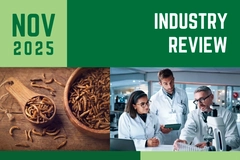Black Sea Grain Initiative: Food flows effectively to global markets but are poorer countries priced out?

06 Apr 2023 --- Eleven months of declining food commodity prices are a testament to the success of the Black Sea Grain Initiative, according to the UN, as 26.88 million metric tons of foodstuffs from Ukraine have reached global ports through sea routes.
However, less than 12% of the food has gone toward Africa, with nations in the continent scrambling to find enough grain to feed their increasingly malnourished populations.
Some countries like Eritrea and the Democratic Republic of Congo, which used to source over 80% of their wheat from Ukraine and Russia, have not received a single shipment from the initiative.
Nonetheless, the importance might be in the grain initiative working and not on who is benefitting, Monika Tothova, UN economist for the Food and Agriculture Organization (FAO), tells NutritionInsight.

“Although some goods are going to food insecure nations directly, in an open international trade environment, the actual destination is not relevant. It is important that the goods are flowing and departing Ukraine and, as such, are putting downward pressure on global prices, benefiting all consumers.”
“The shipment of these commodities contributes to stabilizing world markets,” she highlights.
In the same vein, Ismini Palla, UN spokesperson for the Black Sea Grain Initiative, tells us that “the global humanitarian benefits of the Initiative are evident and are not limited to exports to specific low-income countries.”
Who gets the initiative’s food?
Tothova explains that similarly to other ways of purchasing agricultural products on international markets, the country of destination for the foodstuffs is decided, most frequently, through the use of tenders.
 Only 2.7% of the outbound ships have sailed toward low-income countries, according to the UN.“Simplifying the matter greatly, a country usually issues a tender with a commodity specification (including amount, acceptable origins, purity, protein content, delivery and payment terms, etc.) and different trading companies respond to a particular tender. The issuer of a tender then decides who will be awarded the tender.”
Only 2.7% of the outbound ships have sailed toward low-income countries, according to the UN.“Simplifying the matter greatly, a country usually issues a tender with a commodity specification (including amount, acceptable origins, purity, protein content, delivery and payment terms, etc.) and different trading companies respond to a particular tender. The issuer of a tender then decides who will be awarded the tender.”
The largest traders through the tender system have been China, with 5.95 million metric tons of foodstuffs purchased, followed by Spain’s 4.59 million metric tons, Turkey’s 2.87 million metric tons, Italy’s 1.9 million metric tons and the Netherlands’ 1.65 million metric tons.
According to the UN, 55.8% of the grain export via the Black Sea route has gone to developing countries.
However, the Russian foreign ministry noted in October 2022 that “the geography of the recipients of these cargoes has turned out to be completely inconsistent with the initially declared humanitarian objectives,” pointing that “needy states such as Somalia, Ethiopia, Yemen, Sudan and Afghanistan have received just 3% of food, mostly from the World Food Program (WFP).”
As of the publication of this article, the percentage for the five countries has decreased to 2.67%. Moreover, UN data from the Black Sea Grain Initiative Joint Coordination Centre shows that globally the share going to what they catalog as “low-income countries” is the same at 2.7%.
Are Ukrainian grains still cheap?
Ukraine has one of the world’s most fertile soils. Its black earth or chernozem, next to the country having some of the lowest wages in Europe, allowed poor nations to source grain cheaply before the war.
“Countries traditionally source their food commodities from specific locations due to quality and cost considerations. For example, in the past, wheat from the Black Sea was enjoying a price advantage in North Africa and the Near East due to geographical proximity (which resulted in lower transportation costs) and competitive pricing,” Tothova explains.
“Countries shopping for higher protein content in wheat, would typically source from France or Canada (depending on the year, as weather conditions impact the protein content),” she continues.
However, Ukrainian commodities are not as cheap anymore due to higher shipping and logistical costs from “demurrage in Istanbul” (where ships are inspected) with vessels waiting for entry and exit clearance to and from Ukrainian ports, as ship merchants have to price being delayed sometimes for weeks. At one point 165 ships were “stuck” and ships had to wait 15 days for inspection.
Russia pushes up prices
Russia has been repeatedly accused of delaying inspections, which contributes to making the Black Sea Grain Initiative food less affordable for some countries. Furthermore, the country not giving certainty over renewing the initiative leads to spikes in grain commodity prices. Egypt has had to recur to an IMF loan to be able to keep purchasing wheat in global markets.
Egypt has had to recur to an IMF loan to be able to keep purchasing wheat in global markets.
“Uncertainty about renewal introduces uncertainty to the markets and puts upward pressure on the prices. However, the actual impact on global prices would also be impacted by other factors, such as crop conditions, production outlook, etc.,” underscores Tothova.
“Ukrainian commodities are usually priced lower than comparable goods from other origins, as the shipping costs and logistics costs are higher,” she continues.
This has a double negative effect of raising prices for the initiative commodities and by causing harm to Ukrainian farmers.
“In practice, this means that Ukrainian farmers are getting lower prices at the farm gate, which in the longer term will impact their production decisions.”
In fact, these decisions are already occurring, with the USDA predicting 4.5 million metric tons fewer crop outputs in the country. The UN prediction is even lower at 7 million metric tons lost. Ukrainian farmers are receiving some funds from the US and the EU. However, the war and disruptions to corn drying due to blackouts are straining farmers.
In contrast, according to the USDA, Russia is set to export a record 43.5 million metric tons of wheat during the 2022/2023 agricultural year that ends in June. Between February 15 and June 30, Russia is set to export 25.5 million metric tons of grain, compared to last year’s 11 million metric tons.
Africa gets the shortest wheat straw?
Africa has received 11.6% of the total foodstuffs traded through the Black Sea Grain Initiative – compared to the 42.8% going to Europe and the 45.5% to Asia.
Egypt, which has received one-third of the initiatives food outbound for Africa, saw its wheat imports from Ukraine slashed by half.
“Egypt, the world’s largest wheat importer, in 2021 imported 69% of its wheat from Russia, 19 percent from Ukraine and the rest from Australia, Romania and France. In 2022, although the bulk was imported from Russia (57%), 13% originated from Romania and France, around 9% from Ukraine and small amounts from Bulgaria, Australia, Germany, US, India, Lithuania and Brazil,” Tothova explains.
 Currency depreciation is isolating countries like Lebanon, which can't afford to compete in free markets.Moreover, these imports are ever more expensive and stretch Egypt and other countries’ finances to their absolute limits.
Currency depreciation is isolating countries like Lebanon, which can't afford to compete in free markets.Moreover, these imports are ever more expensive and stretch Egypt and other countries’ finances to their absolute limits.
This is prompting some nations to turn to local foods such as cassava or yam, with other countries opting to switch to rice.
Running out of money for food
According to the Food Policy Research Institute, Egypt spent US$5.7 billion only on wheat imports in 2022, doubling the expenditure of 2021. The country was forced to take an IMF loan of US$3 billion in December.
The WEF Global Risks Report of 2023 highlights that two other African nations are in a simultaneous debt and food crisis, Ghana and Tunisia. Outside of Africa, Pakistan and Lebanon are also experiencing increased instability due to a lack of both food and foreign currency reserves. Pakistan is in the final stages of finalizing a US$6.5 billion IMF loan.
Pakistan used to source 60% of its grain from Ukraine, according to the USDA, but so far has received 61,815 metric tons of food from the initiative, or 0.23% of all shipped food.
According to non-governmental organization (NGO) Care, Lebanon used to source 66% of its wheat from Ukraine. So far, the country has only received 70,880 metric tons from the Black Sea Grain Initiative – 0.26% of all goods shipped – with the last shipment sailing in November.
The central administration of statistics of Lebanon puts food inflation at 261% in February, with the WFP saying food prices have risen 2,300% during the past three years.
The WFP is supporting 74,000 families with food parcels. However, more action is needed as an Integrated Food Security Phase Classification Acute Food Insecurity Analysis predicts that this month 2.26 million people in the country need urgent food assistance.
Overrun WFP
Palla explains that the Black Sea Grain Initiative has led to “benefits for millions of vulnerable people around the world.”
“An essential source of supplies for the WFP has been restored, with over half a million metric tons of wheat having been transported since August, supporting ongoing humanitarian operations in Afghanistan, the Horn of Africa (Djibouti, Ethiopia, Kenya, Somalia) and Yemen,” Palla explains. 382 million people are facing a hunger crisis, the most since the 90s.
382 million people are facing a hunger crisis, the most since the 90s.
“Ukrainian exports to the developing and least developed countries have resumed, which have come to a complete halt during the first months of the war,” she underscores.
However, due to its high prices, the WFP can’t purchase Ukrainian grain at the rate it was doing before the war. In 2021 the program bought 880,000 metric tons from Ukraine for US$260.1 million. In comparison, the WFP received US$68 million last August to purchase 150,000 metric tons, signaling costs have gone up almost 40%.
The WFP does not have the money to aid the 382 million people facing a hunger crisis, with the organization suspending efforts in some regions as their funds dry up.
Such is the case in South Sudan, where, while the WFP admits the country faces the worst year in terms of hunger since its independence in 2011, the organization decided in June 2022 to only target two-thirds of the starving nation as it ran out of funds.
The Black Sea Grain Initiative is set to expire in 42 days. Russian authorities are meeting today with Turkish ones – as Turkey mediates between the nation and Ukraine – to stress that they will only extend the deal if obstacles for Russian foods and fertilizers exports are removed.
Stephane Dujarric, UN spokesperson, said last month the UN remains “totally committed to the Black Sea Grain Initiative and the “efforts to facilitate the export of Russian food and fertilizer.”
By Marc Cervera













